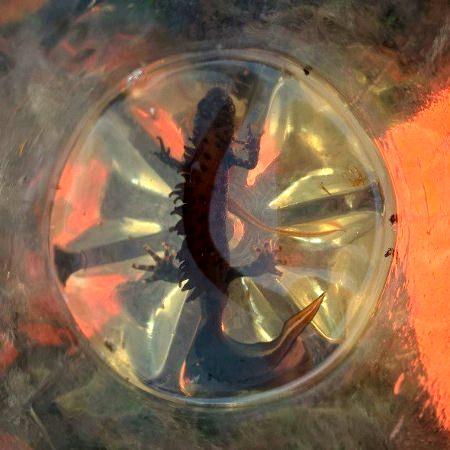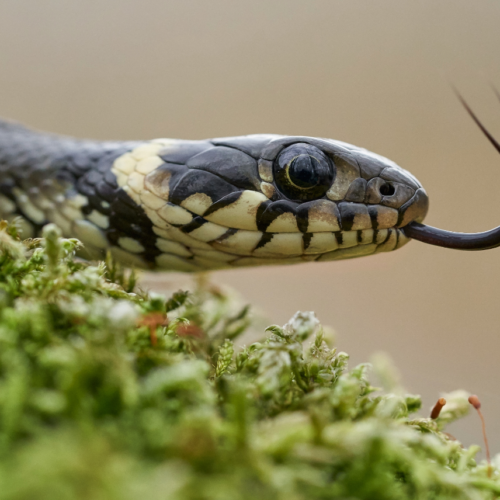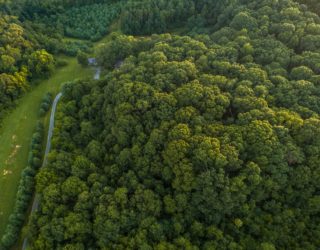It’s day one and I’ve loaded up one of Thomson Ecology’s Land Rovers with approximately 350 bottle traps and bamboo canes. I’ve got the maps, risk assessments and travel details.
I’ve also got enough clothes for the week to fulfil every eventuality – I can’t help it, I’m an ecologist so practicality is my middle name! The sun is shining, daffodils are out and the birds are flying around overhead as we hit the road and are on our way to monitor a great crested newt population.
After reaching the site, I’m joined by my colleague, Sarah. A quick “recce” of the site reveals that storm Katie has filled up the ponds, which is great news for our great crested newts. Whilst thankfully the worst of storm Katie has now passed, the rain remains and we deploy bottle traps in six ponds in the pouring rain. No one could doubt our dedication as we continue working through the downpour. We retire for an hour to refuel and dry off in a local pub while we wait for darkness. You can really tell the evenings are getting longer these days even with dark rain clouds overhead. Armed with torches we step out into the dark. Thankfully the rain has abated for now….
The ponds are teeming with life! Within minutes we discover the underwater world of the ponds, and find beetles, snails and leeches, not to mention newts. We find all three species from the warty black great crested newts to the dainty palmate males with their webbed black hind feet, and some very pregnant female smooth newts.
Elated, we go to bed just as another rain cloud passes over.
The morning dawns bright and clear and with it we see plenty of newts! Great crested, palmate and smooth newts. It is very exciting, not to mention reassuring, to see such numbers in such a small area.
Sarah is swapped for Kate, one of our eager new graduates, and she’s in luck as the sun is set to stay out. That afternoon’s bottle trap deployment is quite exciting as the birds are out to keep us company – we see kestrels hunting, buzzards circling, and the chiffchaffs have started singing. Even a green woodpecker can be heard. We find plenty of newt eggs this time, all neatly laid on water mint with the leaves neatly folded around them.
Unfortunately, not all wildlife is welcome, especially from the point of view of newts. We discovered that a rat had caught some great crested newts and eaten them, leaving behind their toxic skin turned inside out. It made for a gruesome sight, especially as some of the remains appeared to belong to a heavily pregnant female – the eggs were found scattered around the body.
With the sun out the evening feels even longer and we wait in a local pub again until the darkness descends. I saw a bat on our return, which is a good sign that the evening is sufficiently warm, and our torching brings up lots of results again. Once finished, we do our best not to get lost in the dark and make our way home to bed.
The morning breaks sunny and bright again and we are rewarded for our early start with even more newts than before. Pulling up some traps, we wonder if the canes will hold as they bend and strain to pull up a trap heaving with newts. I took seven great crested newts out of one trap, along with smooth and palmate newts sharing it. I’ve never seen so many in one trap. We headed out again a little after breakfast, this time to check for reptiles. We’d heard rumours of 4ft grass snakes and common lizards using the site. But unfortunately for us, none were basking that morning, possibly due to the obvious presence of kestrels and buzzards, not to mention the odd dog walker out enjoying the spring sunshine.
The third and last night of our trip arrives and we trek out again to bottle trap the last two ponds. There’s quite a walk in-between them this time, but that gives us an excellent opportunity to see if we can spot any more wildlife, especially as there is evidence of a badger sett and a fox on site.
One of the remaining ponds was quite a challenge to bottle trap as its bed was made up of extremely hard substrate. Thankfully I’d prepared for this eventuality and had brought a selection of thin canes with me, but it still remained a struggle. With much puffing and effort we managed to install them safely albeit with a few more calories burned than expected. Torching in this area was tricky due to negotiating the mud and a large badger sett nearby. Unfortunately we didn’t get many newts this time, in fact only one. However, we were rewarded with a very bright sky and got to enjoy some excellent star gazing on our walk home with a tawny owl calling in the distance.
Our last morning and we were both feeling a little sad to be finishing. This morning was cold, far colder than I would have liked it to be, the temperature having dropped just before dawn unexpectedly. We did however find lots of newts in one pond, including some very fine male great crested newts, pregnant great crested newts, dainty palmates and spotty smooths. This made for an exciting final morning.
Loading up the Landrover again, I hit the road. It’s a bit muddier than when I began, and smelling distinctly of pond water. Returning to the office means unloading and washing. Due to the nature of amphibians and the risk of possible diseases, we always disinfect everything thoroughly. We did this with our boots as we walked around site, and always used clean bottle traps. But now we have about 300 bottle traps to wash, dry and put away. However, it’s a small price to pay for getting to see so many newts all week.
As this is an ongoing monitoring programme to assess the great crested newt population, a team will return throughout the summer to count and monitor their population, so stay tuned for more updates!











